Business Strategy and Firm Performance Analysis
VerifiedAdded on 2020/10/22
|13
|3929
|138
AI Summary
The provided assignment details a comprehensive analysis of business strategy and its impact on firm performance. It involves examining the role of emotions in family business strategy, crafting and executing strategy concepts, and understanding the dynamics of knowledge-intensive entrepreneurship. The assignment also covers global corporate strategy and trade policy, taxes and business strategy, and how to measure the information systems-business strategy relationship. A summary of relevant literature is provided, including studies on business strategy and firm performance, executive compensation, and organizational responsiveness to work-life balance issues.
Contribute Materials
Your contribution can guide someone’s learning journey. Share your
documents today.
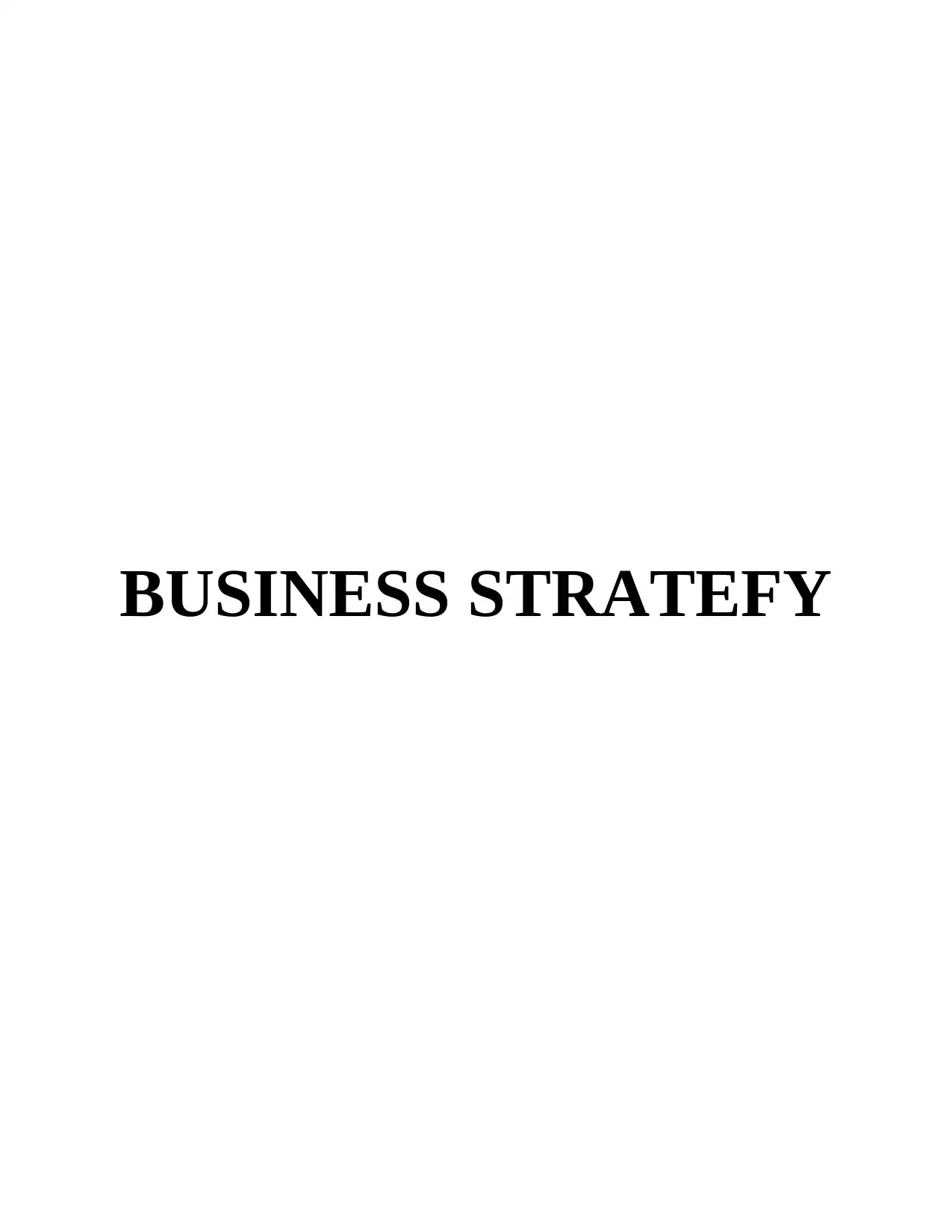
BUSINESS STRATEFY
Secure Best Marks with AI Grader
Need help grading? Try our AI Grader for instant feedback on your assignments.
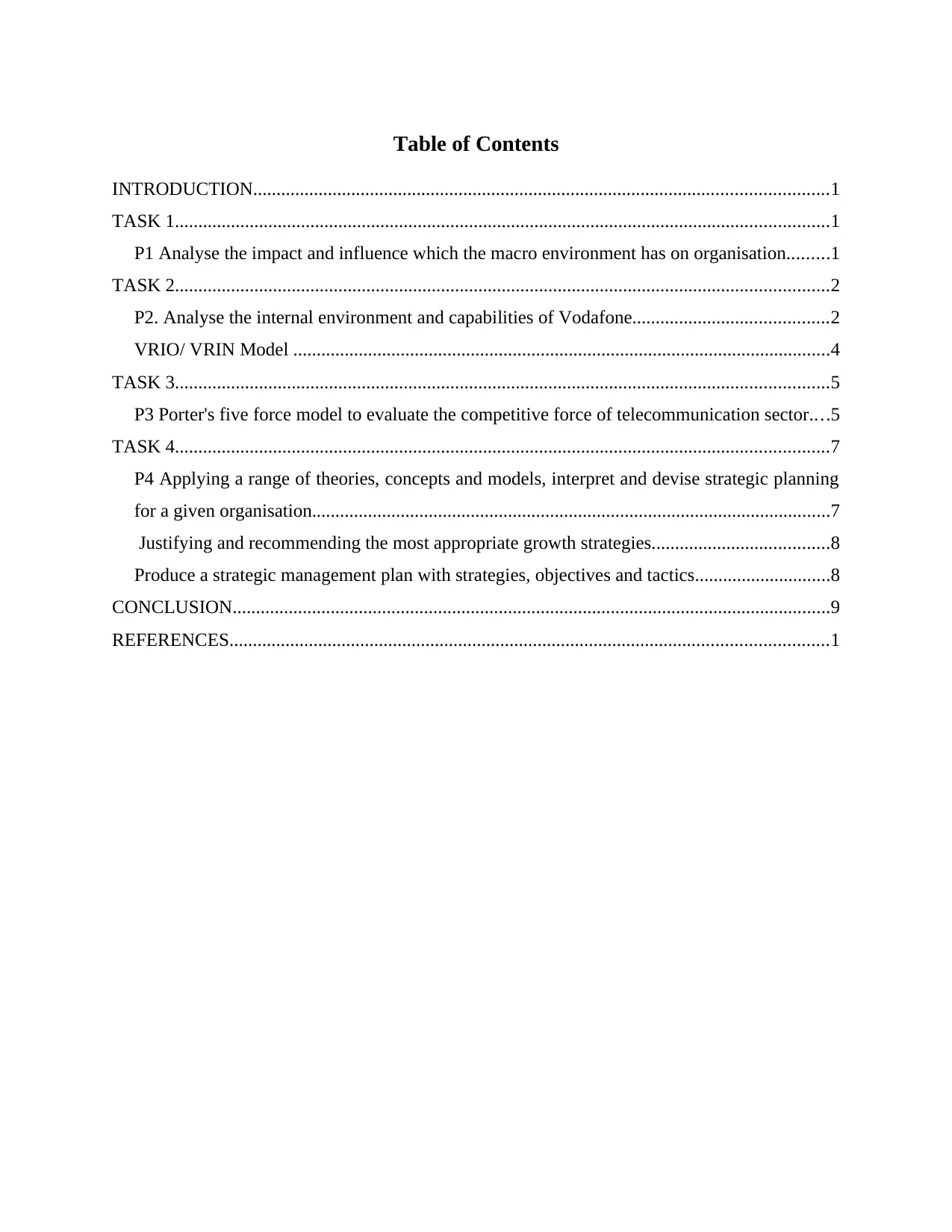
Table of Contents
INTRODUCTION...........................................................................................................................1
TASK 1............................................................................................................................................1
P1 Analyse the impact and influence which the macro environment has on organisation.........1
TASK 2............................................................................................................................................2
P2. Analyse the internal environment and capabilities of Vodafone..........................................2
VRIO/ VRIN Model ...................................................................................................................4
TASK 3............................................................................................................................................5
P3 Porter's five force model to evaluate the competitive force of telecommunication sector....5
TASK 4............................................................................................................................................7
P4 Applying a range of theories, concepts and models, interpret and devise strategic planning
for a given organisation...............................................................................................................7
Justifying and recommending the most appropriate growth strategies......................................8
Produce a strategic management plan with strategies, objectives and tactics.............................8
CONCLUSION................................................................................................................................9
REFERENCES................................................................................................................................1
INTRODUCTION...........................................................................................................................1
TASK 1............................................................................................................................................1
P1 Analyse the impact and influence which the macro environment has on organisation.........1
TASK 2............................................................................................................................................2
P2. Analyse the internal environment and capabilities of Vodafone..........................................2
VRIO/ VRIN Model ...................................................................................................................4
TASK 3............................................................................................................................................5
P3 Porter's five force model to evaluate the competitive force of telecommunication sector....5
TASK 4............................................................................................................................................7
P4 Applying a range of theories, concepts and models, interpret and devise strategic planning
for a given organisation...............................................................................................................7
Justifying and recommending the most appropriate growth strategies......................................8
Produce a strategic management plan with strategies, objectives and tactics.............................8
CONCLUSION................................................................................................................................9
REFERENCES................................................................................................................................1
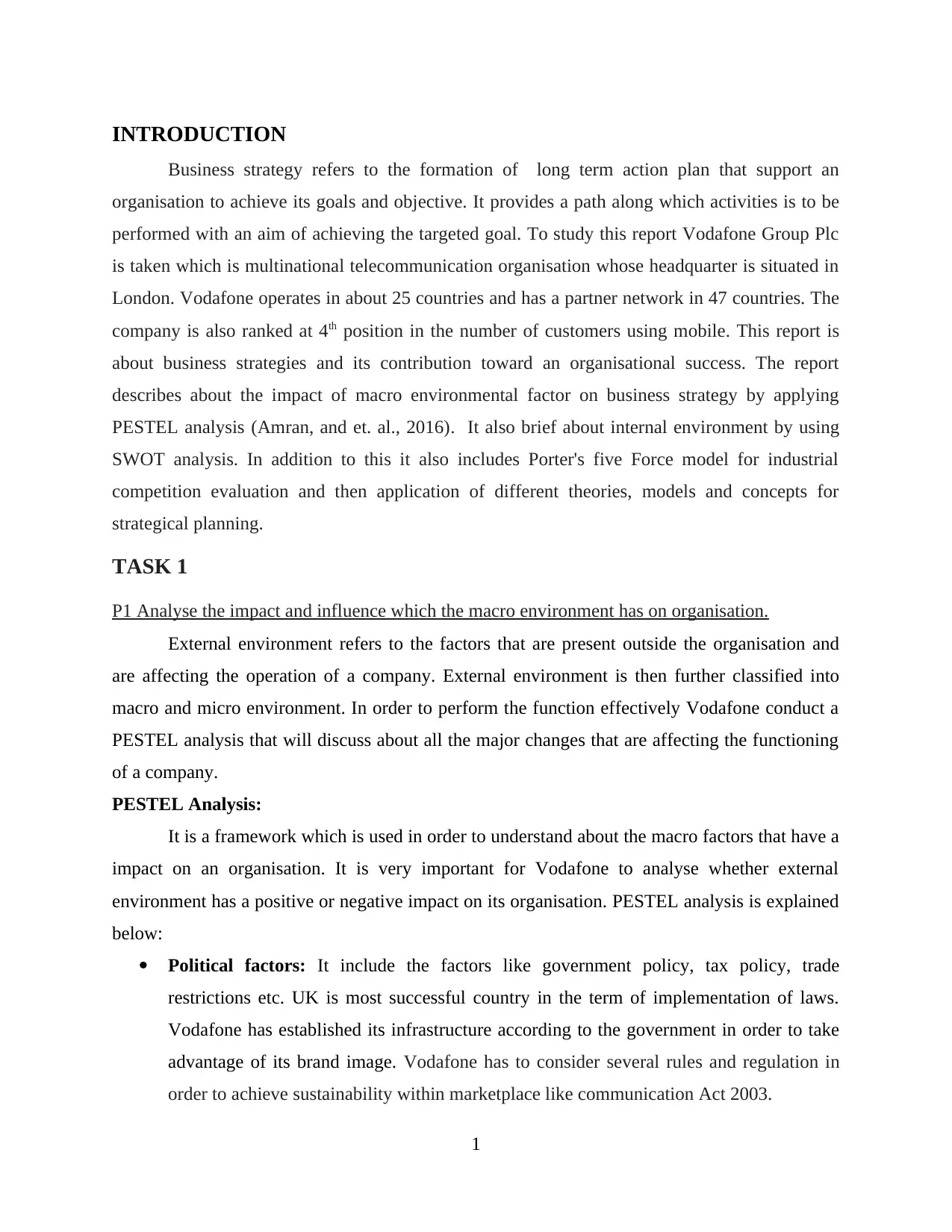
INTRODUCTION
Business strategy refers to the formation of long term action plan that support an
organisation to achieve its goals and objective. It provides a path along which activities is to be
performed with an aim of achieving the targeted goal. To study this report Vodafone Group Plc
is taken which is multinational telecommunication organisation whose headquarter is situated in
London. Vodafone operates in about 25 countries and has a partner network in 47 countries. The
company is also ranked at 4th position in the number of customers using mobile. This report is
about business strategies and its contribution toward an organisational success. The report
describes about the impact of macro environmental factor on business strategy by applying
PESTEL analysis (Amran, and et. al., 2016). It also brief about internal environment by using
SWOT analysis. In addition to this it also includes Porter's five Force model for industrial
competition evaluation and then application of different theories, models and concepts for
strategical planning.
TASK 1
P1 Analyse the impact and influence which the macro environment has on organisation.
External environment refers to the factors that are present outside the organisation and
are affecting the operation of a company. External environment is then further classified into
macro and micro environment. In order to perform the function effectively Vodafone conduct a
PESTEL analysis that will discuss about all the major changes that are affecting the functioning
of a company.
PESTEL Analysis:
It is a framework which is used in order to understand about the macro factors that have a
impact on an organisation. It is very important for Vodafone to analyse whether external
environment has a positive or negative impact on its organisation. PESTEL analysis is explained
below:
Political factors: It include the factors like government policy, tax policy, trade
restrictions etc. UK is most successful country in the term of implementation of laws.
Vodafone has established its infrastructure according to the government in order to take
advantage of its brand image. Vodafone has to consider several rules and regulation in
order to achieve sustainability within marketplace like communication Act 2003.
1
Business strategy refers to the formation of long term action plan that support an
organisation to achieve its goals and objective. It provides a path along which activities is to be
performed with an aim of achieving the targeted goal. To study this report Vodafone Group Plc
is taken which is multinational telecommunication organisation whose headquarter is situated in
London. Vodafone operates in about 25 countries and has a partner network in 47 countries. The
company is also ranked at 4th position in the number of customers using mobile. This report is
about business strategies and its contribution toward an organisational success. The report
describes about the impact of macro environmental factor on business strategy by applying
PESTEL analysis (Amran, and et. al., 2016). It also brief about internal environment by using
SWOT analysis. In addition to this it also includes Porter's five Force model for industrial
competition evaluation and then application of different theories, models and concepts for
strategical planning.
TASK 1
P1 Analyse the impact and influence which the macro environment has on organisation.
External environment refers to the factors that are present outside the organisation and
are affecting the operation of a company. External environment is then further classified into
macro and micro environment. In order to perform the function effectively Vodafone conduct a
PESTEL analysis that will discuss about all the major changes that are affecting the functioning
of a company.
PESTEL Analysis:
It is a framework which is used in order to understand about the macro factors that have a
impact on an organisation. It is very important for Vodafone to analyse whether external
environment has a positive or negative impact on its organisation. PESTEL analysis is explained
below:
Political factors: It include the factors like government policy, tax policy, trade
restrictions etc. UK is most successful country in the term of implementation of laws.
Vodafone has established its infrastructure according to the government in order to take
advantage of its brand image. Vodafone has to consider several rules and regulation in
order to achieve sustainability within marketplace like communication Act 2003.
1
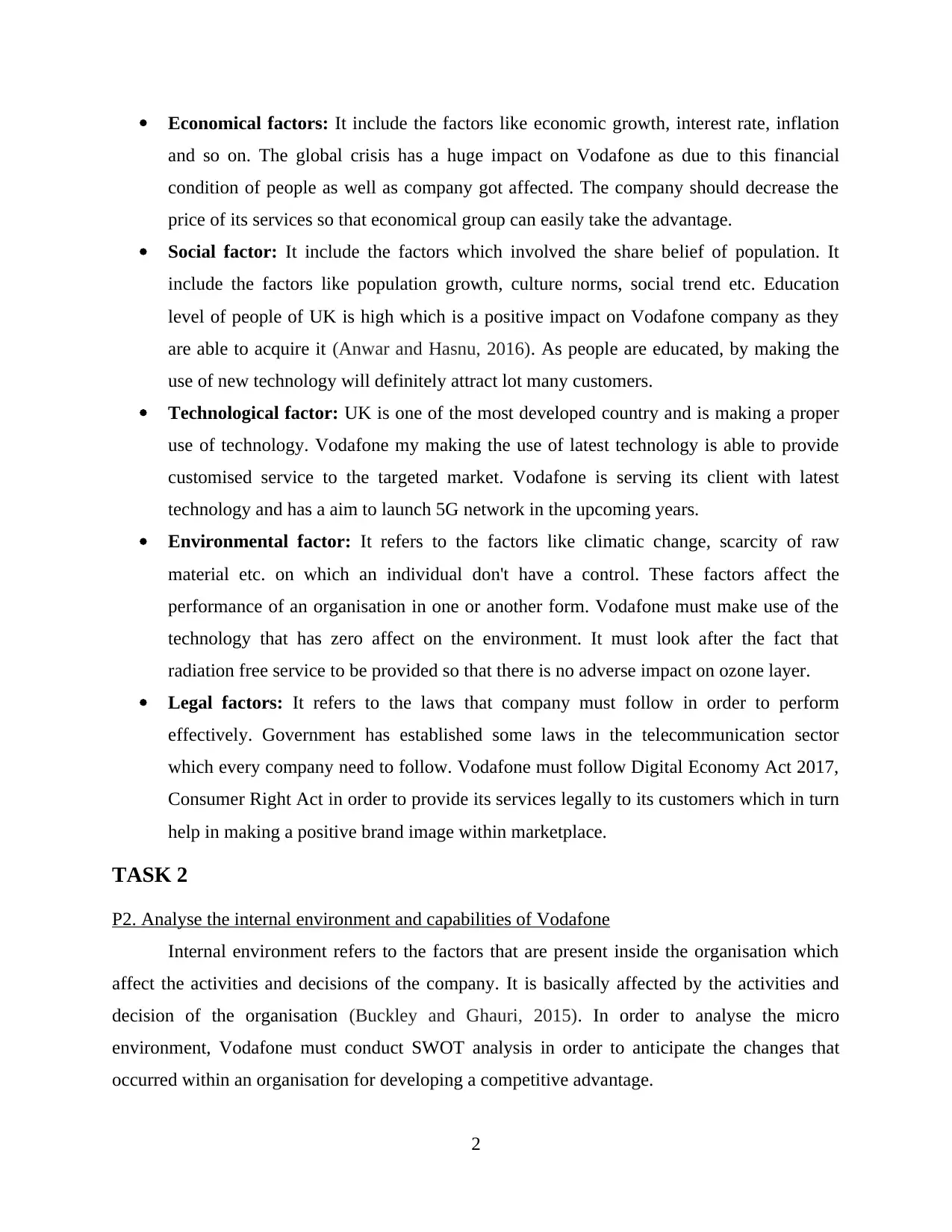
Economical factors: It include the factors like economic growth, interest rate, inflation
and so on. The global crisis has a huge impact on Vodafone as due to this financial
condition of people as well as company got affected. The company should decrease the
price of its services so that economical group can easily take the advantage.
Social factor: It include the factors which involved the share belief of population. It
include the factors like population growth, culture norms, social trend etc. Education
level of people of UK is high which is a positive impact on Vodafone company as they
are able to acquire it (Anwar and Hasnu, 2016). As people are educated, by making the
use of new technology will definitely attract lot many customers.
Technological factor: UK is one of the most developed country and is making a proper
use of technology. Vodafone my making the use of latest technology is able to provide
customised service to the targeted market. Vodafone is serving its client with latest
technology and has a aim to launch 5G network in the upcoming years.
Environmental factor: It refers to the factors like climatic change, scarcity of raw
material etc. on which an individual don't have a control. These factors affect the
performance of an organisation in one or another form. Vodafone must make use of the
technology that has zero affect on the environment. It must look after the fact that
radiation free service to be provided so that there is no adverse impact on ozone layer.
Legal factors: It refers to the laws that company must follow in order to perform
effectively. Government has established some laws in the telecommunication sector
which every company need to follow. Vodafone must follow Digital Economy Act 2017,
Consumer Right Act in order to provide its services legally to its customers which in turn
help in making a positive brand image within marketplace.
TASK 2
P2. Analyse the internal environment and capabilities of Vodafone
Internal environment refers to the factors that are present inside the organisation which
affect the activities and decisions of the company. It is basically affected by the activities and
decision of the organisation (Buckley and Ghauri, 2015). In order to analyse the micro
environment, Vodafone must conduct SWOT analysis in order to anticipate the changes that
occurred within an organisation for developing a competitive advantage.
2
and so on. The global crisis has a huge impact on Vodafone as due to this financial
condition of people as well as company got affected. The company should decrease the
price of its services so that economical group can easily take the advantage.
Social factor: It include the factors which involved the share belief of population. It
include the factors like population growth, culture norms, social trend etc. Education
level of people of UK is high which is a positive impact on Vodafone company as they
are able to acquire it (Anwar and Hasnu, 2016). As people are educated, by making the
use of new technology will definitely attract lot many customers.
Technological factor: UK is one of the most developed country and is making a proper
use of technology. Vodafone my making the use of latest technology is able to provide
customised service to the targeted market. Vodafone is serving its client with latest
technology and has a aim to launch 5G network in the upcoming years.
Environmental factor: It refers to the factors like climatic change, scarcity of raw
material etc. on which an individual don't have a control. These factors affect the
performance of an organisation in one or another form. Vodafone must make use of the
technology that has zero affect on the environment. It must look after the fact that
radiation free service to be provided so that there is no adverse impact on ozone layer.
Legal factors: It refers to the laws that company must follow in order to perform
effectively. Government has established some laws in the telecommunication sector
which every company need to follow. Vodafone must follow Digital Economy Act 2017,
Consumer Right Act in order to provide its services legally to its customers which in turn
help in making a positive brand image within marketplace.
TASK 2
P2. Analyse the internal environment and capabilities of Vodafone
Internal environment refers to the factors that are present inside the organisation which
affect the activities and decisions of the company. It is basically affected by the activities and
decision of the organisation (Buckley and Ghauri, 2015). In order to analyse the micro
environment, Vodafone must conduct SWOT analysis in order to anticipate the changes that
occurred within an organisation for developing a competitive advantage.
2
Secure Best Marks with AI Grader
Need help grading? Try our AI Grader for instant feedback on your assignments.
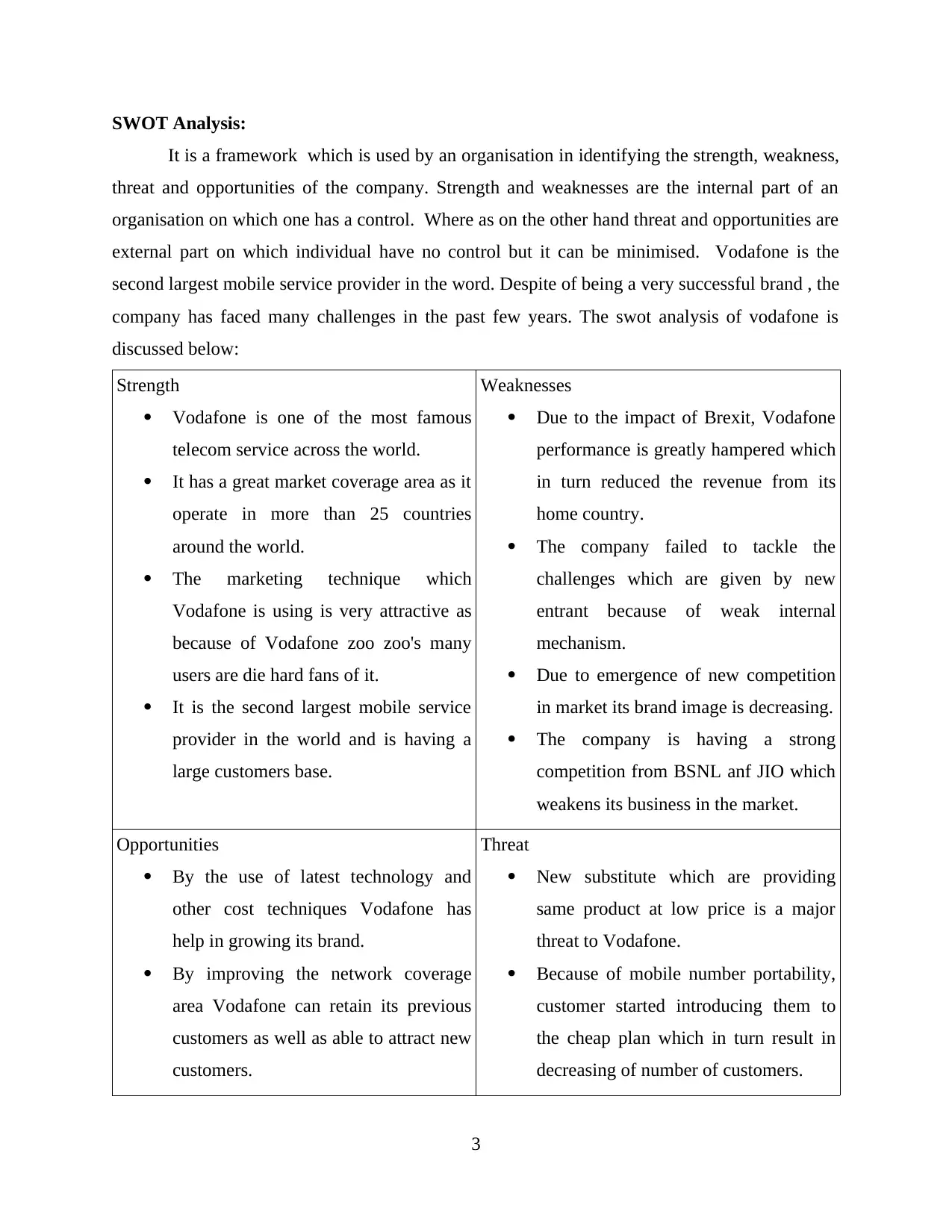
SWOT Analysis:
It is a framework which is used by an organisation in identifying the strength, weakness,
threat and opportunities of the company. Strength and weaknesses are the internal part of an
organisation on which one has a control. Where as on the other hand threat and opportunities are
external part on which individual have no control but it can be minimised. Vodafone is the
second largest mobile service provider in the word. Despite of being a very successful brand , the
company has faced many challenges in the past few years. The swot analysis of vodafone is
discussed below:
Strength
Vodafone is one of the most famous
telecom service across the world.
It has a great market coverage area as it
operate in more than 25 countries
around the world.
The marketing technique which
Vodafone is using is very attractive as
because of Vodafone zoo zoo's many
users are die hard fans of it.
It is the second largest mobile service
provider in the world and is having a
large customers base.
Weaknesses
Due to the impact of Brexit, Vodafone
performance is greatly hampered which
in turn reduced the revenue from its
home country.
The company failed to tackle the
challenges which are given by new
entrant because of weak internal
mechanism.
Due to emergence of new competition
in market its brand image is decreasing.
The company is having a strong
competition from BSNL anf JIO which
weakens its business in the market.
Opportunities
By the use of latest technology and
other cost techniques Vodafone has
help in growing its brand.
By improving the network coverage
area Vodafone can retain its previous
customers as well as able to attract new
customers.
Threat
New substitute which are providing
same product at low price is a major
threat to Vodafone.
Because of mobile number portability,
customer started introducing them to
the cheap plan which in turn result in
decreasing of number of customers.
3
It is a framework which is used by an organisation in identifying the strength, weakness,
threat and opportunities of the company. Strength and weaknesses are the internal part of an
organisation on which one has a control. Where as on the other hand threat and opportunities are
external part on which individual have no control but it can be minimised. Vodafone is the
second largest mobile service provider in the word. Despite of being a very successful brand , the
company has faced many challenges in the past few years. The swot analysis of vodafone is
discussed below:
Strength
Vodafone is one of the most famous
telecom service across the world.
It has a great market coverage area as it
operate in more than 25 countries
around the world.
The marketing technique which
Vodafone is using is very attractive as
because of Vodafone zoo zoo's many
users are die hard fans of it.
It is the second largest mobile service
provider in the world and is having a
large customers base.
Weaknesses
Due to the impact of Brexit, Vodafone
performance is greatly hampered which
in turn reduced the revenue from its
home country.
The company failed to tackle the
challenges which are given by new
entrant because of weak internal
mechanism.
Due to emergence of new competition
in market its brand image is decreasing.
The company is having a strong
competition from BSNL anf JIO which
weakens its business in the market.
Opportunities
By the use of latest technology and
other cost techniques Vodafone has
help in growing its brand.
By improving the network coverage
area Vodafone can retain its previous
customers as well as able to attract new
customers.
Threat
New substitute which are providing
same product at low price is a major
threat to Vodafone.
Because of mobile number portability,
customer started introducing them to
the cheap plan which in turn result in
decreasing of number of customers.
3
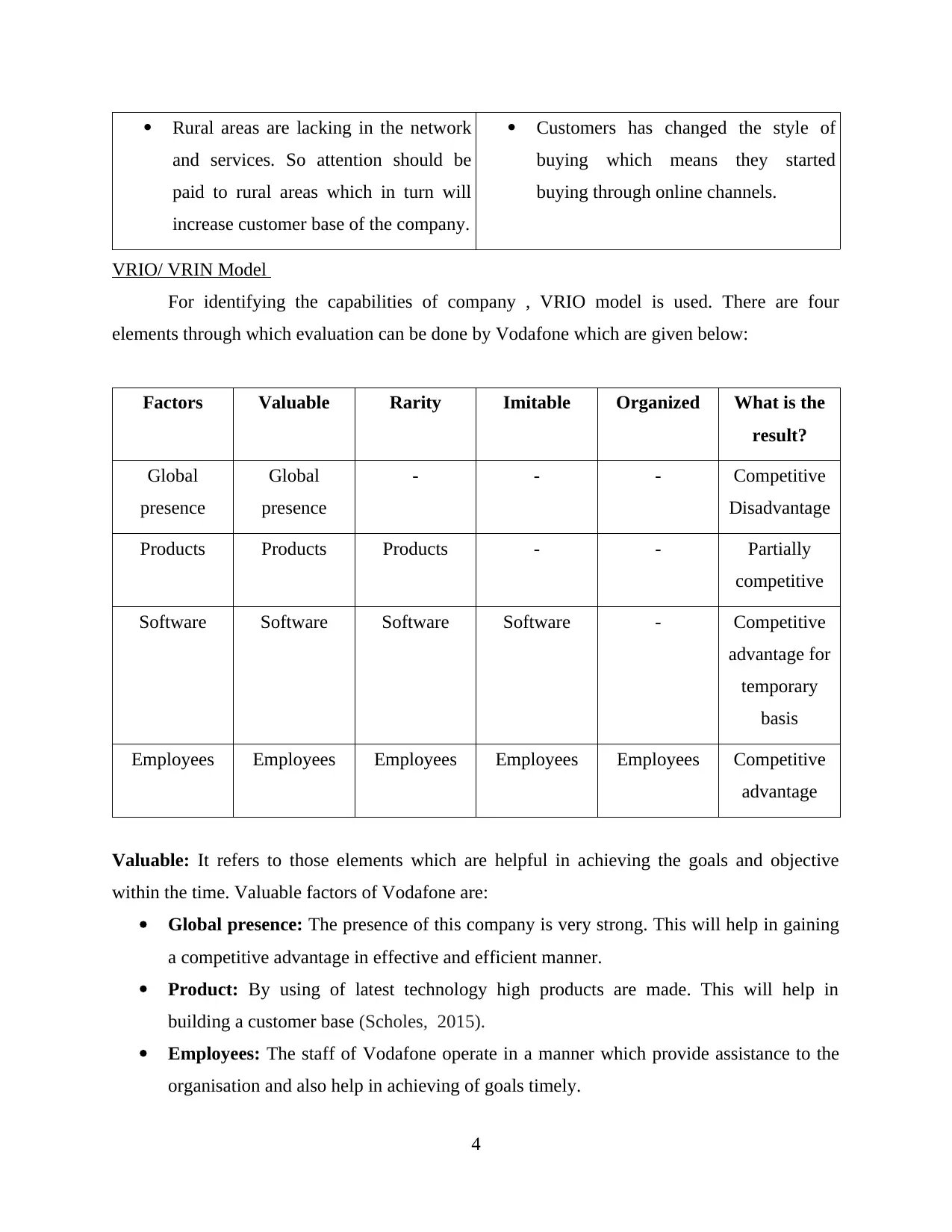
Rural areas are lacking in the network
and services. So attention should be
paid to rural areas which in turn will
increase customer base of the company.
Customers has changed the style of
buying which means they started
buying through online channels.
VRIO/ VRIN Model
For identifying the capabilities of company , VRIO model is used. There are four
elements through which evaluation can be done by Vodafone which are given below:
Factors Valuable Rarity Imitable Organized What is the
result?
Global
presence
Global
presence
- - - Competitive
Disadvantage
Products Products Products - - Partially
competitive
Software Software Software Software - Competitive
advantage for
temporary
basis
Employees Employees Employees Employees Employees Competitive
advantage
Valuable: It refers to those elements which are helpful in achieving the goals and objective
within the time. Valuable factors of Vodafone are:
Global presence: The presence of this company is very strong. This will help in gaining
a competitive advantage in effective and efficient manner.
Product: By using of latest technology high products are made. This will help in
building a customer base (Scholes, 2015).
Employees: The staff of Vodafone operate in a manner which provide assistance to the
organisation and also help in achieving of goals timely.
4
and services. So attention should be
paid to rural areas which in turn will
increase customer base of the company.
Customers has changed the style of
buying which means they started
buying through online channels.
VRIO/ VRIN Model
For identifying the capabilities of company , VRIO model is used. There are four
elements through which evaluation can be done by Vodafone which are given below:
Factors Valuable Rarity Imitable Organized What is the
result?
Global
presence
Global
presence
- - - Competitive
Disadvantage
Products Products Products - - Partially
competitive
Software Software Software Software - Competitive
advantage for
temporary
basis
Employees Employees Employees Employees Employees Competitive
advantage
Valuable: It refers to those elements which are helpful in achieving the goals and objective
within the time. Valuable factors of Vodafone are:
Global presence: The presence of this company is very strong. This will help in gaining
a competitive advantage in effective and efficient manner.
Product: By using of latest technology high products are made. This will help in
building a customer base (Scholes, 2015).
Employees: The staff of Vodafone operate in a manner which provide assistance to the
organisation and also help in achieving of goals timely.
4
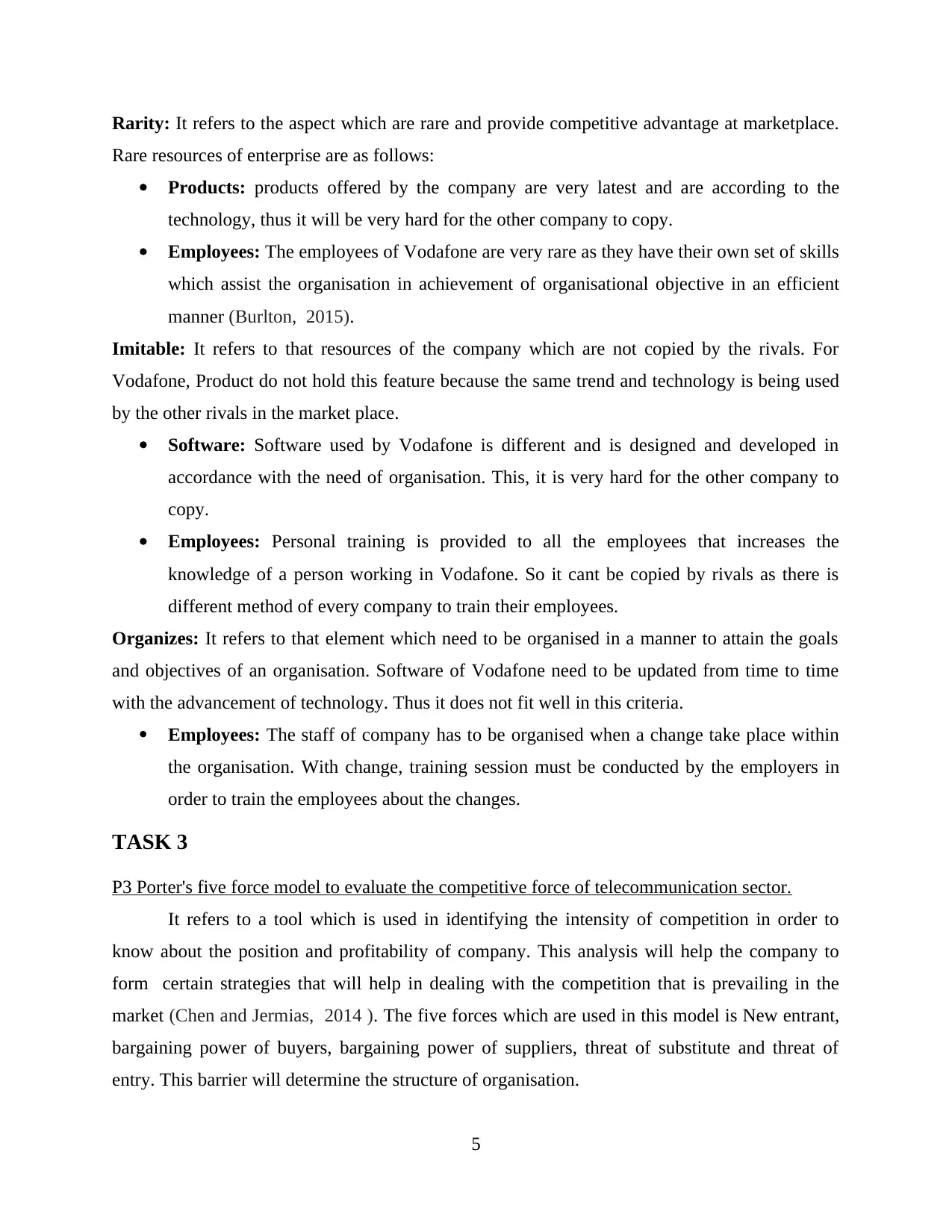
Rarity: It refers to the aspect which are rare and provide competitive advantage at marketplace.
Rare resources of enterprise are as follows:
Products: products offered by the company are very latest and are according to the
technology, thus it will be very hard for the other company to copy.
Employees: The employees of Vodafone are very rare as they have their own set of skills
which assist the organisation in achievement of organisational objective in an efficient
manner (Burlton, 2015).
Imitable: It refers to that resources of the company which are not copied by the rivals. For
Vodafone, Product do not hold this feature because the same trend and technology is being used
by the other rivals in the market place.
Software: Software used by Vodafone is different and is designed and developed in
accordance with the need of organisation. This, it is very hard for the other company to
copy.
Employees: Personal training is provided to all the employees that increases the
knowledge of a person working in Vodafone. So it cant be copied by rivals as there is
different method of every company to train their employees.
Organizes: It refers to that element which need to be organised in a manner to attain the goals
and objectives of an organisation. Software of Vodafone need to be updated from time to time
with the advancement of technology. Thus it does not fit well in this criteria.
Employees: The staff of company has to be organised when a change take place within
the organisation. With change, training session must be conducted by the employers in
order to train the employees about the changes.
TASK 3
P3 Porter's five force model to evaluate the competitive force of telecommunication sector.
It refers to a tool which is used in identifying the intensity of competition in order to
know about the position and profitability of company. This analysis will help the company to
form certain strategies that will help in dealing with the competition that is prevailing in the
market (Chen and Jermias, 2014 ). The five forces which are used in this model is New entrant,
bargaining power of buyers, bargaining power of suppliers, threat of substitute and threat of
entry. This barrier will determine the structure of organisation.
5
Rare resources of enterprise are as follows:
Products: products offered by the company are very latest and are according to the
technology, thus it will be very hard for the other company to copy.
Employees: The employees of Vodafone are very rare as they have their own set of skills
which assist the organisation in achievement of organisational objective in an efficient
manner (Burlton, 2015).
Imitable: It refers to that resources of the company which are not copied by the rivals. For
Vodafone, Product do not hold this feature because the same trend and technology is being used
by the other rivals in the market place.
Software: Software used by Vodafone is different and is designed and developed in
accordance with the need of organisation. This, it is very hard for the other company to
copy.
Employees: Personal training is provided to all the employees that increases the
knowledge of a person working in Vodafone. So it cant be copied by rivals as there is
different method of every company to train their employees.
Organizes: It refers to that element which need to be organised in a manner to attain the goals
and objectives of an organisation. Software of Vodafone need to be updated from time to time
with the advancement of technology. Thus it does not fit well in this criteria.
Employees: The staff of company has to be organised when a change take place within
the organisation. With change, training session must be conducted by the employers in
order to train the employees about the changes.
TASK 3
P3 Porter's five force model to evaluate the competitive force of telecommunication sector.
It refers to a tool which is used in identifying the intensity of competition in order to
know about the position and profitability of company. This analysis will help the company to
form certain strategies that will help in dealing with the competition that is prevailing in the
market (Chen and Jermias, 2014 ). The five forces which are used in this model is New entrant,
bargaining power of buyers, bargaining power of suppliers, threat of substitute and threat of
entry. This barrier will determine the structure of organisation.
5
Paraphrase This Document
Need a fresh take? Get an instant paraphrase of this document with our AI Paraphraser
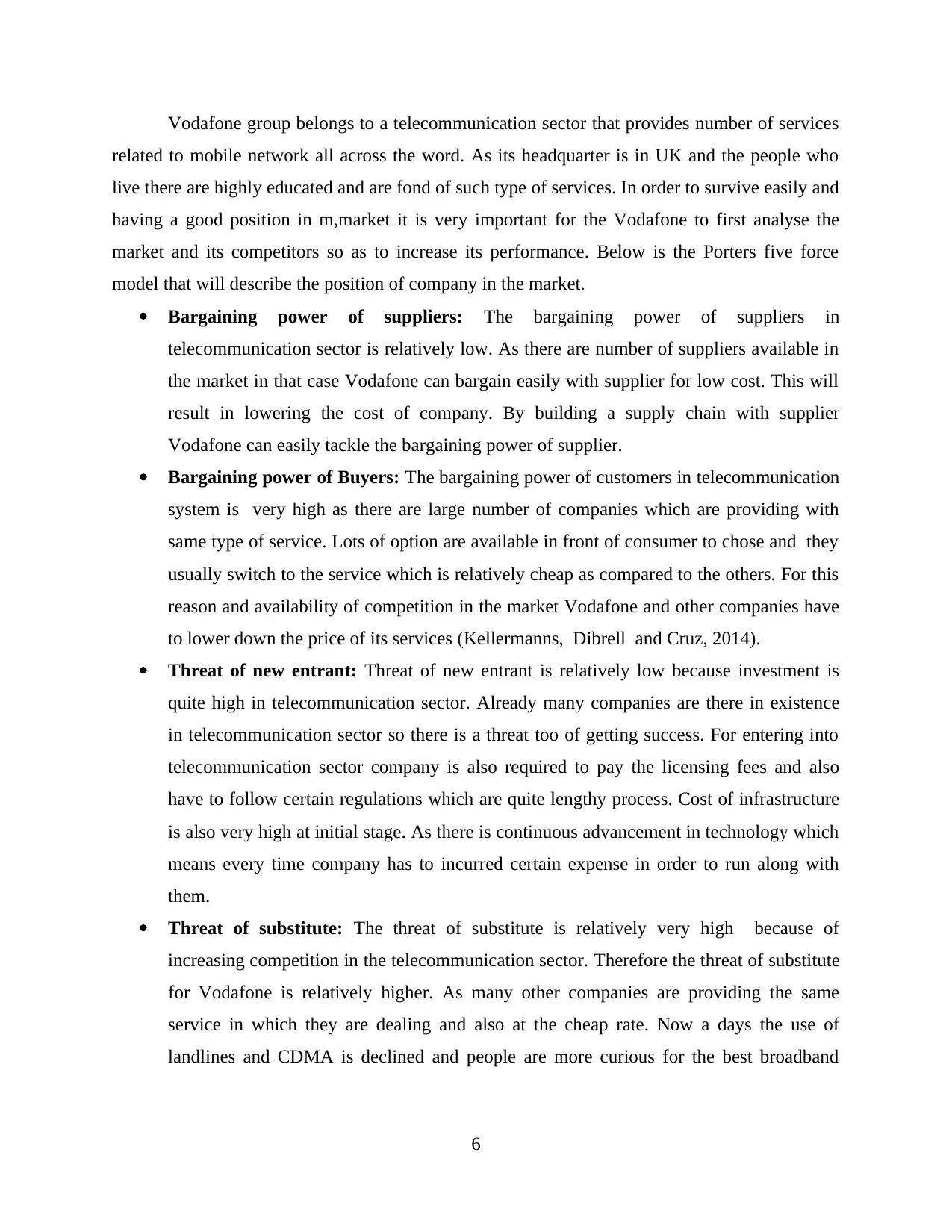
Vodafone group belongs to a telecommunication sector that provides number of services
related to mobile network all across the word. As its headquarter is in UK and the people who
live there are highly educated and are fond of such type of services. In order to survive easily and
having a good position in m,market it is very important for the Vodafone to first analyse the
market and its competitors so as to increase its performance. Below is the Porters five force
model that will describe the position of company in the market.
Bargaining power of suppliers: The bargaining power of suppliers in
telecommunication sector is relatively low. As there are number of suppliers available in
the market in that case Vodafone can bargain easily with supplier for low cost. This will
result in lowering the cost of company. By building a supply chain with supplier
Vodafone can easily tackle the bargaining power of supplier.
Bargaining power of Buyers: The bargaining power of customers in telecommunication
system is very high as there are large number of companies which are providing with
same type of service. Lots of option are available in front of consumer to chose and they
usually switch to the service which is relatively cheap as compared to the others. For this
reason and availability of competition in the market Vodafone and other companies have
to lower down the price of its services (Kellermanns, Dibrell and Cruz, 2014).
Threat of new entrant: Threat of new entrant is relatively low because investment is
quite high in telecommunication sector. Already many companies are there in existence
in telecommunication sector so there is a threat too of getting success. For entering into
telecommunication sector company is also required to pay the licensing fees and also
have to follow certain regulations which are quite lengthy process. Cost of infrastructure
is also very high at initial stage. As there is continuous advancement in technology which
means every time company has to incurred certain expense in order to run along with
them.
Threat of substitute: The threat of substitute is relatively very high because of
increasing competition in the telecommunication sector. Therefore the threat of substitute
for Vodafone is relatively higher. As many other companies are providing the same
service in which they are dealing and also at the cheap rate. Now a days the use of
landlines and CDMA is declined and people are more curious for the best broadband
6
related to mobile network all across the word. As its headquarter is in UK and the people who
live there are highly educated and are fond of such type of services. In order to survive easily and
having a good position in m,market it is very important for the Vodafone to first analyse the
market and its competitors so as to increase its performance. Below is the Porters five force
model that will describe the position of company in the market.
Bargaining power of suppliers: The bargaining power of suppliers in
telecommunication sector is relatively low. As there are number of suppliers available in
the market in that case Vodafone can bargain easily with supplier for low cost. This will
result in lowering the cost of company. By building a supply chain with supplier
Vodafone can easily tackle the bargaining power of supplier.
Bargaining power of Buyers: The bargaining power of customers in telecommunication
system is very high as there are large number of companies which are providing with
same type of service. Lots of option are available in front of consumer to chose and they
usually switch to the service which is relatively cheap as compared to the others. For this
reason and availability of competition in the market Vodafone and other companies have
to lower down the price of its services (Kellermanns, Dibrell and Cruz, 2014).
Threat of new entrant: Threat of new entrant is relatively low because investment is
quite high in telecommunication sector. Already many companies are there in existence
in telecommunication sector so there is a threat too of getting success. For entering into
telecommunication sector company is also required to pay the licensing fees and also
have to follow certain regulations which are quite lengthy process. Cost of infrastructure
is also very high at initial stage. As there is continuous advancement in technology which
means every time company has to incurred certain expense in order to run along with
them.
Threat of substitute: The threat of substitute is relatively very high because of
increasing competition in the telecommunication sector. Therefore the threat of substitute
for Vodafone is relatively higher. As many other companies are providing the same
service in which they are dealing and also at the cheap rate. Now a days the use of
landlines and CDMA is declined and people are more curious for the best broadband
6
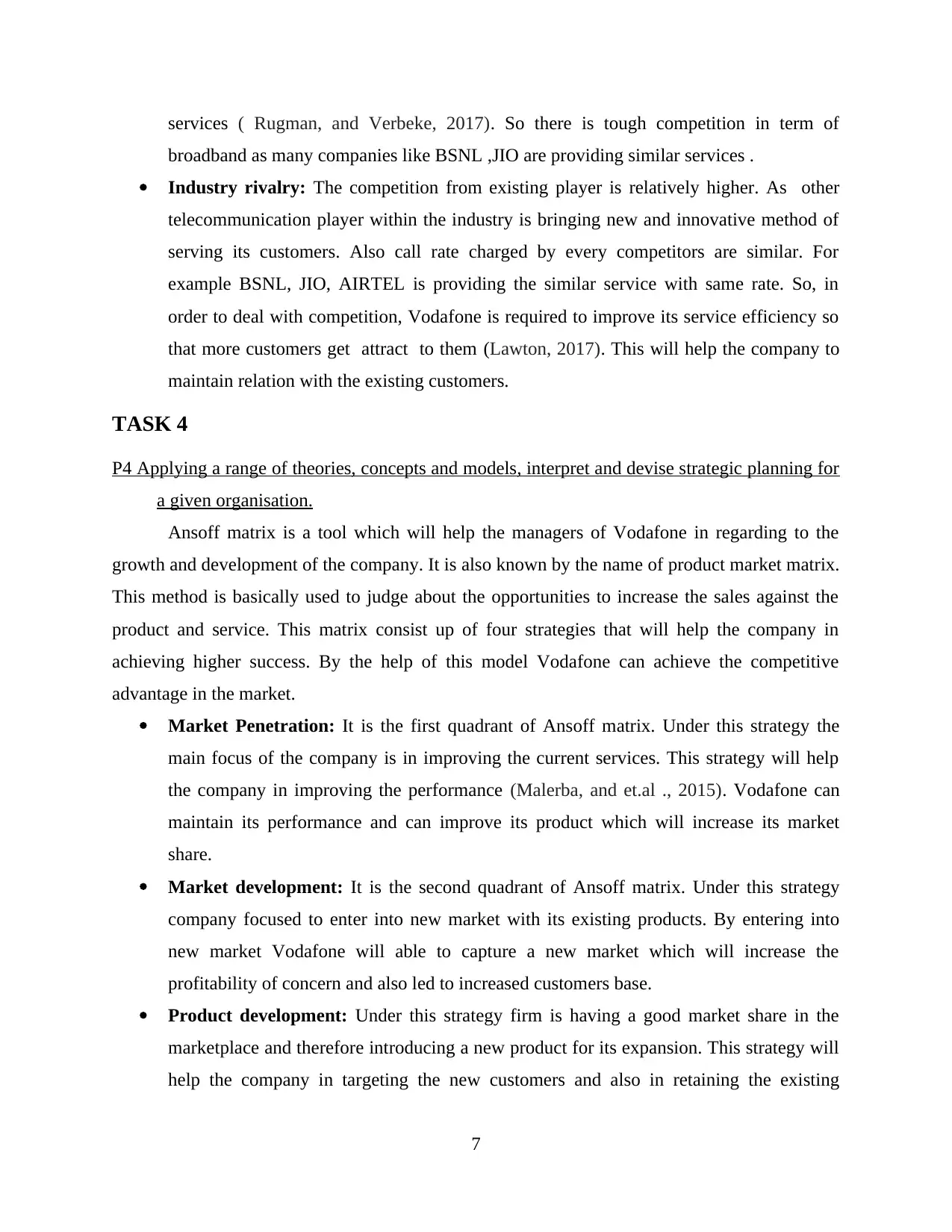
services ( Rugman, and Verbeke, 2017). So there is tough competition in term of
broadband as many companies like BSNL ,JIO are providing similar services .
Industry rivalry: The competition from existing player is relatively higher. As other
telecommunication player within the industry is bringing new and innovative method of
serving its customers. Also call rate charged by every competitors are similar. For
example BSNL, JIO, AIRTEL is providing the similar service with same rate. So, in
order to deal with competition, Vodafone is required to improve its service efficiency so
that more customers get attract to them (Lawton, 2017). This will help the company to
maintain relation with the existing customers.
TASK 4
P4 Applying a range of theories, concepts and models, interpret and devise strategic planning for
a given organisation.
Ansoff matrix is a tool which will help the managers of Vodafone in regarding to the
growth and development of the company. It is also known by the name of product market matrix.
This method is basically used to judge about the opportunities to increase the sales against the
product and service. This matrix consist up of four strategies that will help the company in
achieving higher success. By the help of this model Vodafone can achieve the competitive
advantage in the market.
Market Penetration: It is the first quadrant of Ansoff matrix. Under this strategy the
main focus of the company is in improving the current services. This strategy will help
the company in improving the performance (Malerba, and et.al ., 2015). Vodafone can
maintain its performance and can improve its product which will increase its market
share.
Market development: It is the second quadrant of Ansoff matrix. Under this strategy
company focused to enter into new market with its existing products. By entering into
new market Vodafone will able to capture a new market which will increase the
profitability of concern and also led to increased customers base.
Product development: Under this strategy firm is having a good market share in the
marketplace and therefore introducing a new product for its expansion. This strategy will
help the company in targeting the new customers and also in retaining the existing
7
broadband as many companies like BSNL ,JIO are providing similar services .
Industry rivalry: The competition from existing player is relatively higher. As other
telecommunication player within the industry is bringing new and innovative method of
serving its customers. Also call rate charged by every competitors are similar. For
example BSNL, JIO, AIRTEL is providing the similar service with same rate. So, in
order to deal with competition, Vodafone is required to improve its service efficiency so
that more customers get attract to them (Lawton, 2017). This will help the company to
maintain relation with the existing customers.
TASK 4
P4 Applying a range of theories, concepts and models, interpret and devise strategic planning for
a given organisation.
Ansoff matrix is a tool which will help the managers of Vodafone in regarding to the
growth and development of the company. It is also known by the name of product market matrix.
This method is basically used to judge about the opportunities to increase the sales against the
product and service. This matrix consist up of four strategies that will help the company in
achieving higher success. By the help of this model Vodafone can achieve the competitive
advantage in the market.
Market Penetration: It is the first quadrant of Ansoff matrix. Under this strategy the
main focus of the company is in improving the current services. This strategy will help
the company in improving the performance (Malerba, and et.al ., 2015). Vodafone can
maintain its performance and can improve its product which will increase its market
share.
Market development: It is the second quadrant of Ansoff matrix. Under this strategy
company focused to enter into new market with its existing products. By entering into
new market Vodafone will able to capture a new market which will increase the
profitability of concern and also led to increased customers base.
Product development: Under this strategy firm is having a good market share in the
marketplace and therefore introducing a new product for its expansion. This strategy will
help the company in targeting the new customers and also in retaining the existing
7
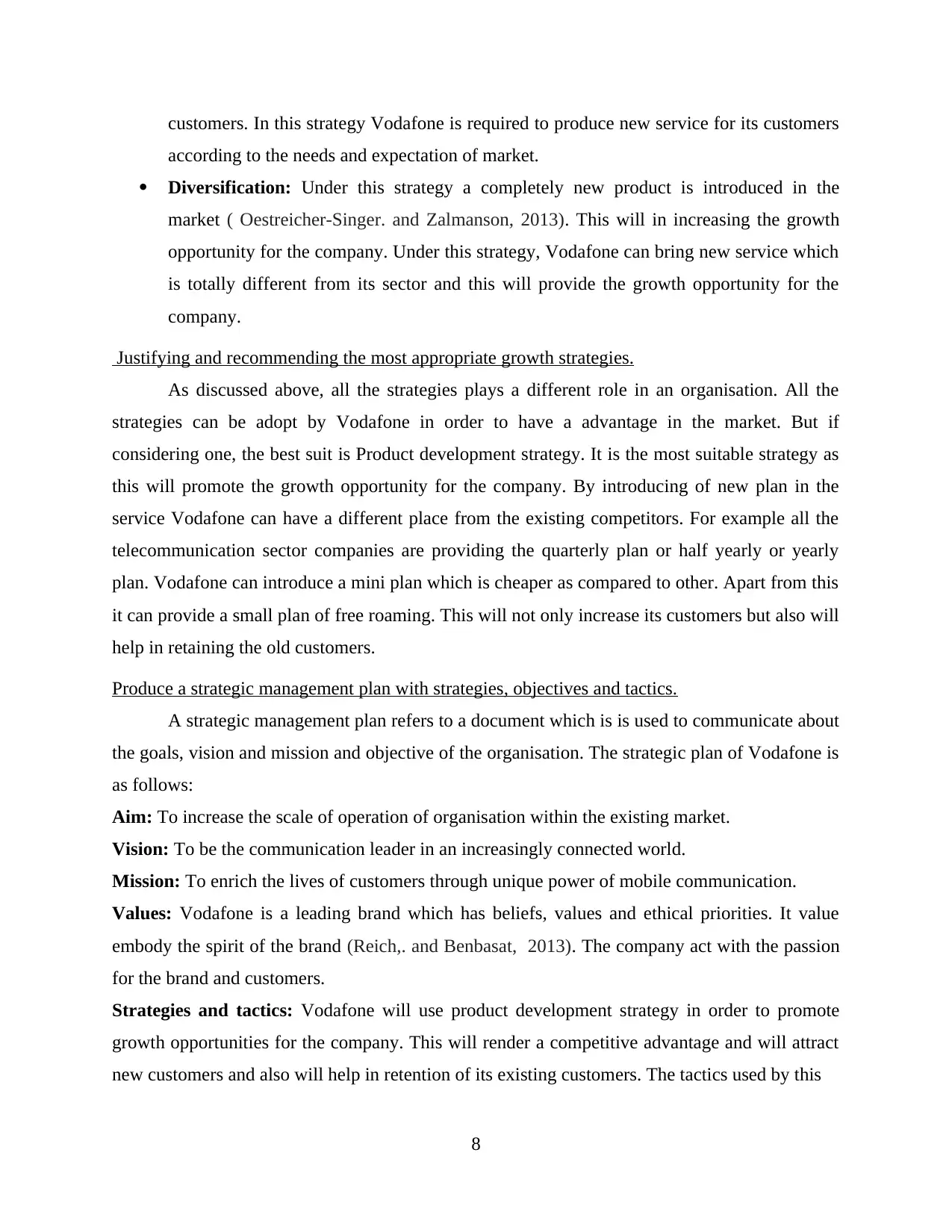
customers. In this strategy Vodafone is required to produce new service for its customers
according to the needs and expectation of market.
Diversification: Under this strategy a completely new product is introduced in the
market ( Oestreicher-Singer. and Zalmanson, 2013). This will in increasing the growth
opportunity for the company. Under this strategy, Vodafone can bring new service which
is totally different from its sector and this will provide the growth opportunity for the
company.
Justifying and recommending the most appropriate growth strategies.
As discussed above, all the strategies plays a different role in an organisation. All the
strategies can be adopt by Vodafone in order to have a advantage in the market. But if
considering one, the best suit is Product development strategy. It is the most suitable strategy as
this will promote the growth opportunity for the company. By introducing of new plan in the
service Vodafone can have a different place from the existing competitors. For example all the
telecommunication sector companies are providing the quarterly plan or half yearly or yearly
plan. Vodafone can introduce a mini plan which is cheaper as compared to other. Apart from this
it can provide a small plan of free roaming. This will not only increase its customers but also will
help in retaining the old customers.
Produce a strategic management plan with strategies, objectives and tactics.
A strategic management plan refers to a document which is is used to communicate about
the goals, vision and mission and objective of the organisation. The strategic plan of Vodafone is
as follows:
Aim: To increase the scale of operation of organisation within the existing market.
Vision: To be the communication leader in an increasingly connected world.
Mission: To enrich the lives of customers through unique power of mobile communication.
Values: Vodafone is a leading brand which has beliefs, values and ethical priorities. It value
embody the spirit of the brand (Reich,. and Benbasat, 2013). The company act with the passion
for the brand and customers.
Strategies and tactics: Vodafone will use product development strategy in order to promote
growth opportunities for the company. This will render a competitive advantage and will attract
new customers and also will help in retention of its existing customers. The tactics used by this
8
according to the needs and expectation of market.
Diversification: Under this strategy a completely new product is introduced in the
market ( Oestreicher-Singer. and Zalmanson, 2013). This will in increasing the growth
opportunity for the company. Under this strategy, Vodafone can bring new service which
is totally different from its sector and this will provide the growth opportunity for the
company.
Justifying and recommending the most appropriate growth strategies.
As discussed above, all the strategies plays a different role in an organisation. All the
strategies can be adopt by Vodafone in order to have a advantage in the market. But if
considering one, the best suit is Product development strategy. It is the most suitable strategy as
this will promote the growth opportunity for the company. By introducing of new plan in the
service Vodafone can have a different place from the existing competitors. For example all the
telecommunication sector companies are providing the quarterly plan or half yearly or yearly
plan. Vodafone can introduce a mini plan which is cheaper as compared to other. Apart from this
it can provide a small plan of free roaming. This will not only increase its customers but also will
help in retaining the old customers.
Produce a strategic management plan with strategies, objectives and tactics.
A strategic management plan refers to a document which is is used to communicate about
the goals, vision and mission and objective of the organisation. The strategic plan of Vodafone is
as follows:
Aim: To increase the scale of operation of organisation within the existing market.
Vision: To be the communication leader in an increasingly connected world.
Mission: To enrich the lives of customers through unique power of mobile communication.
Values: Vodafone is a leading brand which has beliefs, values and ethical priorities. It value
embody the spirit of the brand (Reich,. and Benbasat, 2013). The company act with the passion
for the brand and customers.
Strategies and tactics: Vodafone will use product development strategy in order to promote
growth opportunities for the company. This will render a competitive advantage and will attract
new customers and also will help in retention of its existing customers. The tactics used by this
8
Secure Best Marks with AI Grader
Need help grading? Try our AI Grader for instant feedback on your assignments.
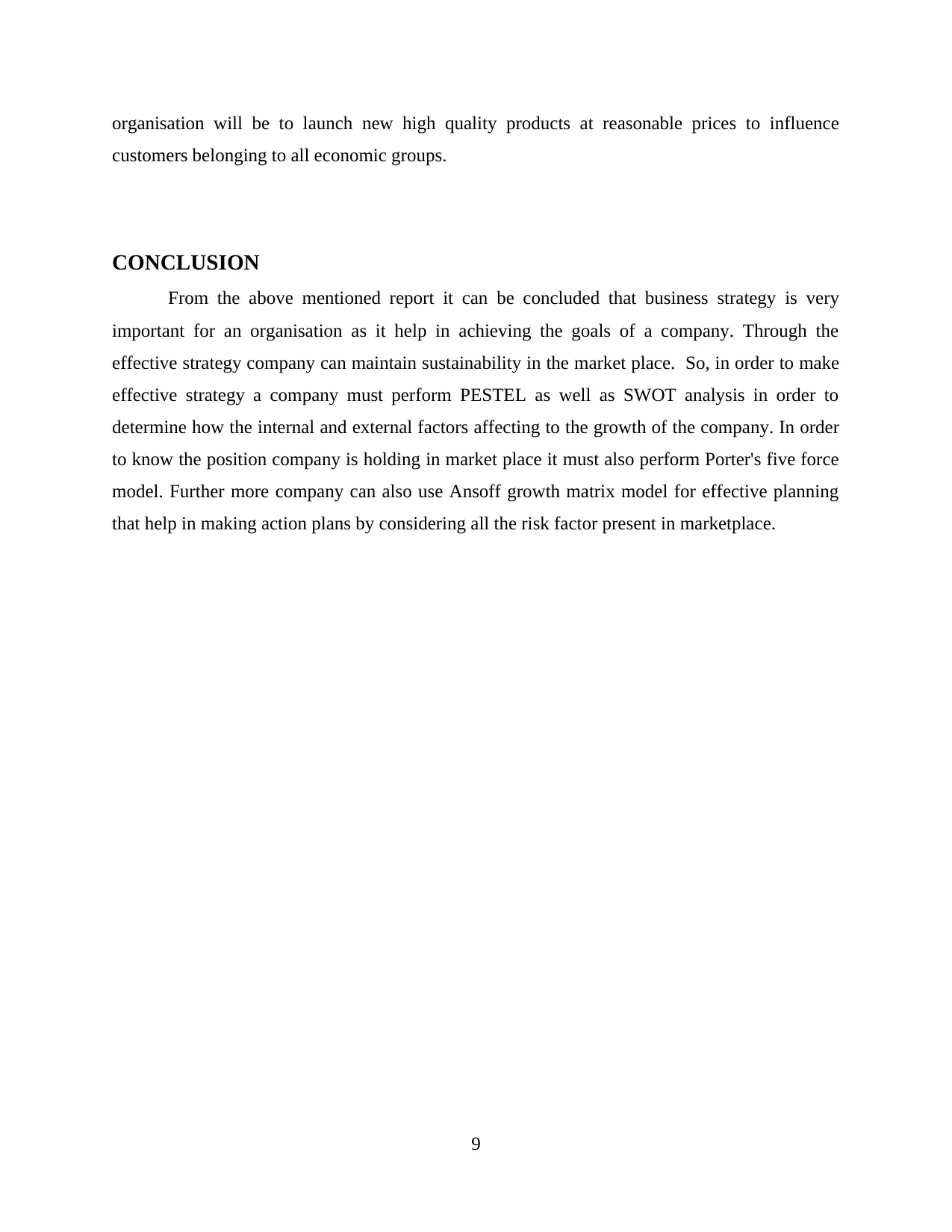
organisation will be to launch new high quality products at reasonable prices to influence
customers belonging to all economic groups.
CONCLUSION
From the above mentioned report it can be concluded that business strategy is very
important for an organisation as it help in achieving the goals of a company. Through the
effective strategy company can maintain sustainability in the market place. So, in order to make
effective strategy a company must perform PESTEL as well as SWOT analysis in order to
determine how the internal and external factors affecting to the growth of the company. In order
to know the position company is holding in market place it must also perform Porter's five force
model. Further more company can also use Ansoff growth matrix model for effective planning
that help in making action plans by considering all the risk factor present in marketplace.
9
customers belonging to all economic groups.
CONCLUSION
From the above mentioned report it can be concluded that business strategy is very
important for an organisation as it help in achieving the goals of a company. Through the
effective strategy company can maintain sustainability in the market place. So, in order to make
effective strategy a company must perform PESTEL as well as SWOT analysis in order to
determine how the internal and external factors affecting to the growth of the company. In order
to know the position company is holding in market place it must also perform Porter's five force
model. Further more company can also use Ansoff growth matrix model for effective planning
that help in making action plans by considering all the risk factor present in marketplace.
9

10
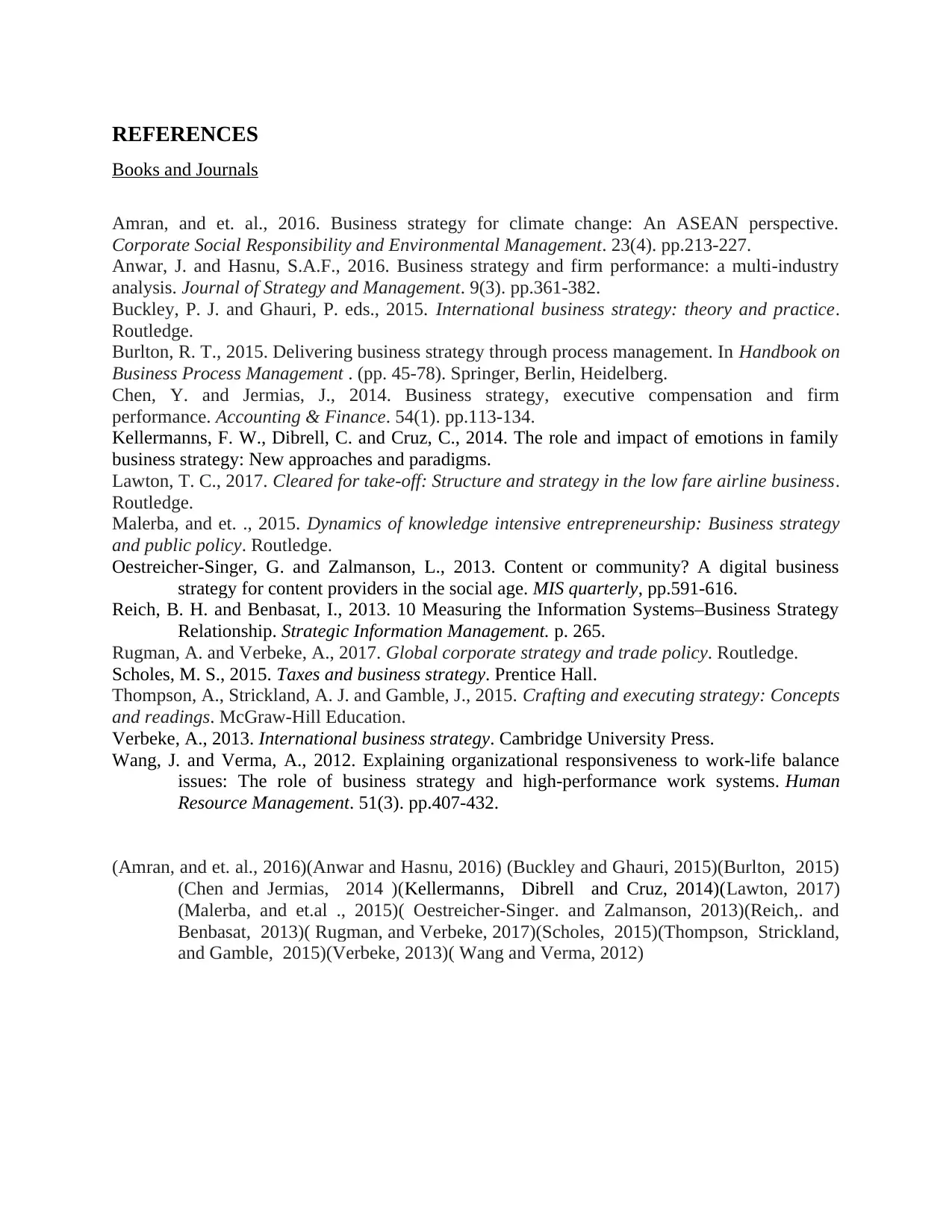
REFERENCES
Books and Journals
Amran, and et. al., 2016. Business strategy for climate change: An ASEAN perspective.
Corporate Social Responsibility and Environmental Management. 23(4). pp.213-227.
Anwar, J. and Hasnu, S.A.F., 2016. Business strategy and firm performance: a multi-industry
analysis. Journal of Strategy and Management. 9(3). pp.361-382.
Buckley, P. J. and Ghauri, P. eds., 2015. International business strategy: theory and practice.
Routledge.
Burlton, R. T., 2015. Delivering business strategy through process management. In Handbook on
Business Process Management . (pp. 45-78). Springer, Berlin, Heidelberg.
Chen, Y. and Jermias, J., 2014. Business strategy, executive compensation and firm
performance. Accounting & Finance. 54(1). pp.113-134.
Kellermanns, F. W., Dibrell, C. and Cruz, C., 2014. The role and impact of emotions in family
business strategy: New approaches and paradigms.
Lawton, T. C., 2017. Cleared for take-off: Structure and strategy in the low fare airline business.
Routledge.
Malerba, and et. ., 2015. Dynamics of knowledge intensive entrepreneurship: Business strategy
and public policy. Routledge.
Oestreicher-Singer, G. and Zalmanson, L., 2013. Content or community? A digital business
strategy for content providers in the social age. MIS quarterly, pp.591-616.
Reich, B. H. and Benbasat, I., 2013. 10 Measuring the Information Systems–Business Strategy
Relationship. Strategic Information Management. p. 265.
Rugman, A. and Verbeke, A., 2017. Global corporate strategy and trade policy. Routledge.
Scholes, M. S., 2015. Taxes and business strategy. Prentice Hall.
Thompson, A., Strickland, A. J. and Gamble, J., 2015. Crafting and executing strategy: Concepts
and readings. McGraw-Hill Education.
Verbeke, A., 2013. International business strategy. Cambridge University Press.
Wang, J. and Verma, A., 2012. Explaining organizational responsiveness to work‐life balance
issues: The role of business strategy and high‐performance work systems. Human
Resource Management. 51(3). pp.407-432.
(Amran, and et. al., 2016)(Anwar and Hasnu, 2016) (Buckley and Ghauri, 2015)(Burlton, 2015)
(Chen and Jermias, 2014 )(Kellermanns, Dibrell and Cruz, 2014)(Lawton, 2017)
(Malerba, and et.al ., 2015)( Oestreicher-Singer. and Zalmanson, 2013)(Reich,. and
Benbasat, 2013)( Rugman, and Verbeke, 2017)(Scholes, 2015)(Thompson, Strickland,
and Gamble, 2015)(Verbeke, 2013)( Wang and Verma, 2012)
Books and Journals
Amran, and et. al., 2016. Business strategy for climate change: An ASEAN perspective.
Corporate Social Responsibility and Environmental Management. 23(4). pp.213-227.
Anwar, J. and Hasnu, S.A.F., 2016. Business strategy and firm performance: a multi-industry
analysis. Journal of Strategy and Management. 9(3). pp.361-382.
Buckley, P. J. and Ghauri, P. eds., 2015. International business strategy: theory and practice.
Routledge.
Burlton, R. T., 2015. Delivering business strategy through process management. In Handbook on
Business Process Management . (pp. 45-78). Springer, Berlin, Heidelberg.
Chen, Y. and Jermias, J., 2014. Business strategy, executive compensation and firm
performance. Accounting & Finance. 54(1). pp.113-134.
Kellermanns, F. W., Dibrell, C. and Cruz, C., 2014. The role and impact of emotions in family
business strategy: New approaches and paradigms.
Lawton, T. C., 2017. Cleared for take-off: Structure and strategy in the low fare airline business.
Routledge.
Malerba, and et. ., 2015. Dynamics of knowledge intensive entrepreneurship: Business strategy
and public policy. Routledge.
Oestreicher-Singer, G. and Zalmanson, L., 2013. Content or community? A digital business
strategy for content providers in the social age. MIS quarterly, pp.591-616.
Reich, B. H. and Benbasat, I., 2013. 10 Measuring the Information Systems–Business Strategy
Relationship. Strategic Information Management. p. 265.
Rugman, A. and Verbeke, A., 2017. Global corporate strategy and trade policy. Routledge.
Scholes, M. S., 2015. Taxes and business strategy. Prentice Hall.
Thompson, A., Strickland, A. J. and Gamble, J., 2015. Crafting and executing strategy: Concepts
and readings. McGraw-Hill Education.
Verbeke, A., 2013. International business strategy. Cambridge University Press.
Wang, J. and Verma, A., 2012. Explaining organizational responsiveness to work‐life balance
issues: The role of business strategy and high‐performance work systems. Human
Resource Management. 51(3). pp.407-432.
(Amran, and et. al., 2016)(Anwar and Hasnu, 2016) (Buckley and Ghauri, 2015)(Burlton, 2015)
(Chen and Jermias, 2014 )(Kellermanns, Dibrell and Cruz, 2014)(Lawton, 2017)
(Malerba, and et.al ., 2015)( Oestreicher-Singer. and Zalmanson, 2013)(Reich,. and
Benbasat, 2013)( Rugman, and Verbeke, 2017)(Scholes, 2015)(Thompson, Strickland,
and Gamble, 2015)(Verbeke, 2013)( Wang and Verma, 2012)
1 out of 13
Related Documents
Your All-in-One AI-Powered Toolkit for Academic Success.
+13062052269
info@desklib.com
Available 24*7 on WhatsApp / Email
![[object Object]](/_next/static/media/star-bottom.7253800d.svg)
Unlock your academic potential
© 2024 | Zucol Services PVT LTD | All rights reserved.





